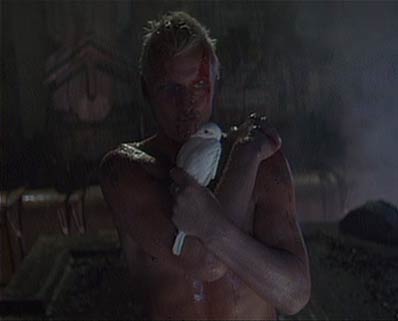Year: 1988
Directed by: Kazuyoshi Katayama
Written by: Kazuyoshi Katayama, Masamune Shirow (manga)
IMDB Reference
Degree of Cyberpunk Visuals: Medium
Correlation to Cyberpunk Themes: High
Key Cast Members:
- Deunan: Masako Katsuki
- Briareos: Yoshisada Sakaguchi
Rating: 7 out of 10
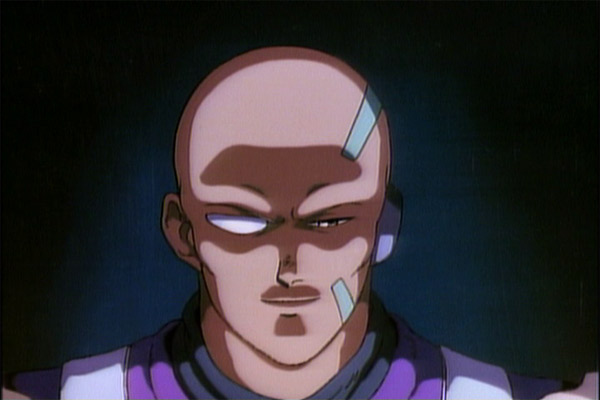
Overview: Released the same year as Akira, this Masamune Shirow story is far more an artifact of 80s Anime, whereas Akira points the way to how anime will look in the 90s. This early Mecha movie is violent, profanity laden and action packed, with a really nice story and interesting philosophical undertones. And interestingly, this is one of the very few animes where the English track is actually the best one.
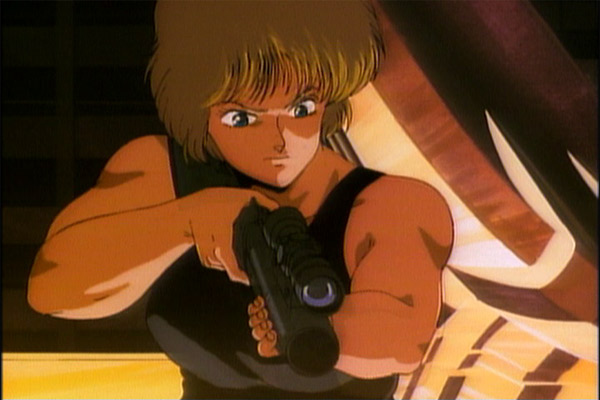
The Story: Appleseed takes place in a dystopian future, in which a city called Olympus has been engineered to be a created as a perfect refuge from the rest of the world. Many of the inhabitants have been bio-engineered “biodroids,” which are half-human, half-cyborgs designed to serve specific roles in the society. An all-powerful computer named GIA controls all city functions, and is just now starting to become responsible for the defense systems. Olympus is so controlled that there is little diversity or struggles required from its inhabitants.
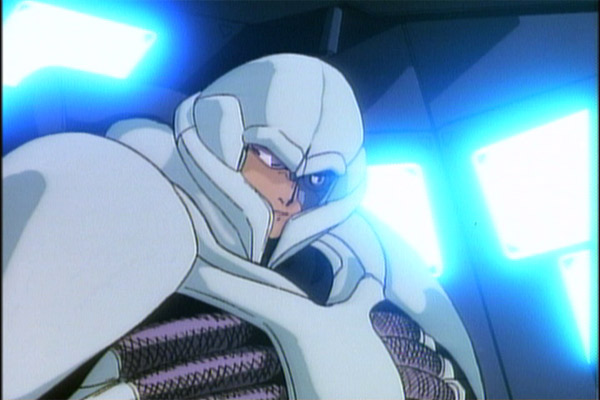
A cyborg terrorist named Sabastian has made it his mission to destroy GIA. He finds a kindred soul in a disenchanted police officer, who’s wife committed suicide after she couldn’t stand living such a controlled existence. They plot to take over the prototype impenetrable tank in order to kill Gia and destroy Olympus. The movie centers around the mecha-laden Swat police force aligning their forces to stop them. In addition to heavy violence, we get MASSIVE amounts of F-bombs dropped here. Its actually rather cool seeing the amount of profanity that is used here - far more than one would expect from an anime such as this.
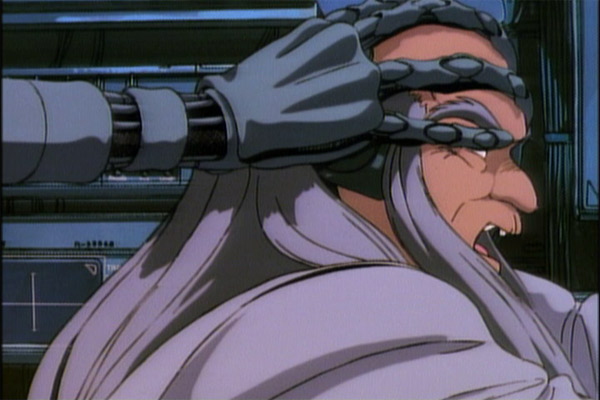
Deunan, a hot police chick and Briareos, a bug-like looking cyborg are Swat team members assigned to stop the terrorists. Incidentally, these two are clearly the precursors for Major Motoko Kusanagi and her cyborg partner, Bateau. While Deunan keeps her clothes on and doesn’t have Motoko’s intelligence, she definitely fills the same roll. Spunkiness is her middle name. The rest of the group, including Sebastian the terrorist, and the rest of the police force all provide decent support.
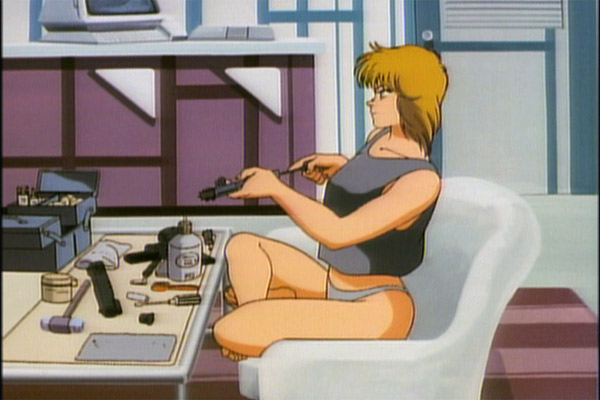
The animation here is still mostly 80s american style. Additionally, unlike the anime of the 90s, the backgrounds are often single, simple colors. While some animation scenes are rather cool, others are really more simple than you’d want. Definitely, the majority of the animation effort is about highlighing Dunan - she definitely looks better than everything else around her. Also, the sound is 80s keyboard music. Sometimes it works, but mostly its just distracting.
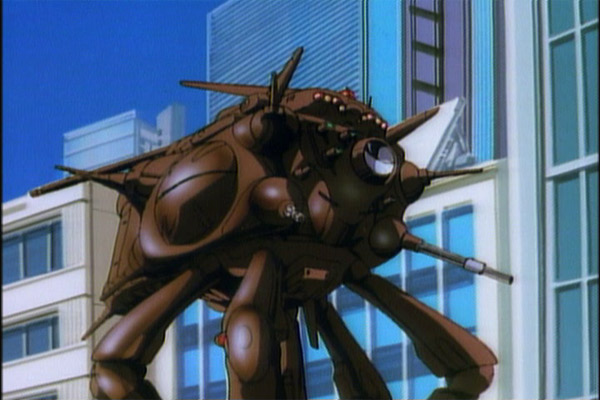
There are a number of messages that Appleseed puts forth. Looking at it today, the most disturbing message deals with Olympus’ rather extreme attempts to protect and inculcate itself from outside terrorists. The symbol for this is a bird in a cage. Considering that the US is in the throws of working this exact issue, Appleseed gives us a stark reminder that we can easily lose the soul of our society while attempting to protect it. Additionally, there are somewhat brief inquiries into what “life” is when examining whether biodroids should be valued similar to humans.
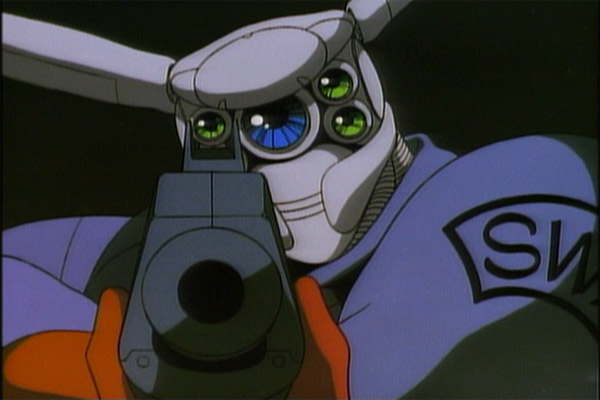
The Bottom Line: Appleseed is a good example of very early Japanese Anime. While its nowhere near the top in terms of animation, the Masamune Shirow’s story is high quality. Truly, the story is why you want to watch this. While the 2004 version definitely wins out on superior graphics, I think the 1988 version is a tighter, more interesting storyline. And if you’ve read the Applesead Manga, then the story, especially the beginning, works far better. You will find yourself becoming connected to the lead characters. But most impressive is the pacing. Appleseed packs an incredible amount of story in 68 minutes - truly, there’s very little fat here.
Year: 1982
Directed by: Steven Lisberger
Written by: Steven Lisberger, Bonnie MacBird
IMDB Reference
Degree of Cyberpunk Visuals: High
Correlation to Cyberpunk Themes: High
Key Cast Members:
Kevin Flynn/Clu: Jeff Bridges
Alan Bradley/Tron: Bruce Boxleitner
Ed Dillinger/Sark/Voice of Master Control Program: David Warner
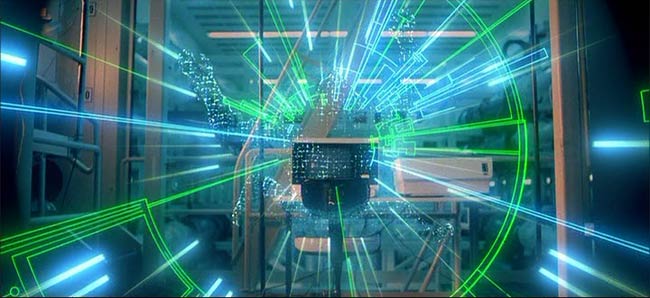
Overview: How could a cyberpunk review site NOT have Tron? We’re talking about the first CG movie, and truly, a groundbreaker VR movie. Make no mistake, this is a pre-cyberpunk movie, complete with corporate greed, theft, integration of human and computers, ubiquitous access to information, a dystopian world (inside the program, anyways), and pure cyberpunk visuals and style. While Tron is slightly cheesy in parts, its still a hell of a ride!
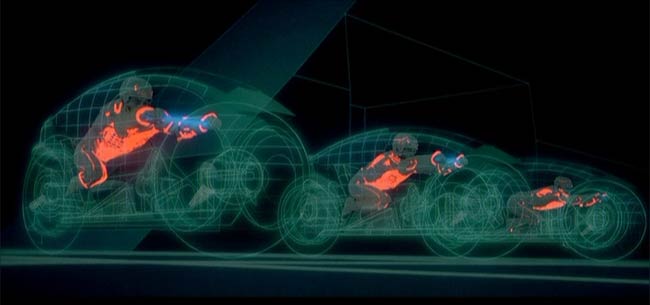
In Tron, a computer programmer (Jeff Bridges) who has his programs stolen from him tries to go back into the corporation to get them, but somehow gets sucked back into the game he developed. From there the fun begins, as Bridges has to square off against contestants and the Master Control Program in order to escape back to the real world. Most of this adventure takes place within the program world, and involves some awesome games and fun chase scenes.
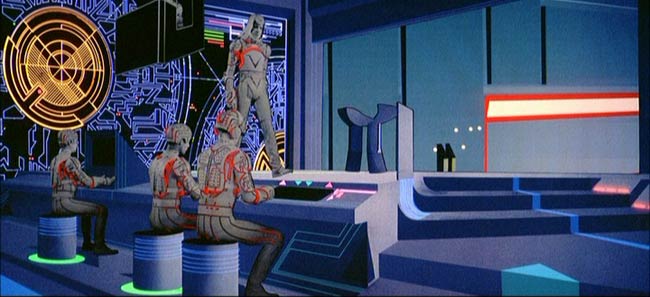
Like the Wizard of Oz before, and eXistenZ and Thirteenth Floor after it, the players in the game bear a striking resemblance to their human users. Some movies call this “residual self image” - others just build this concept into the design of the system. But while this convention existed in fantasy realms, Tron successfully set the pattern for most future VR films - you look the same on the inside of the VR system as you do on the outside.
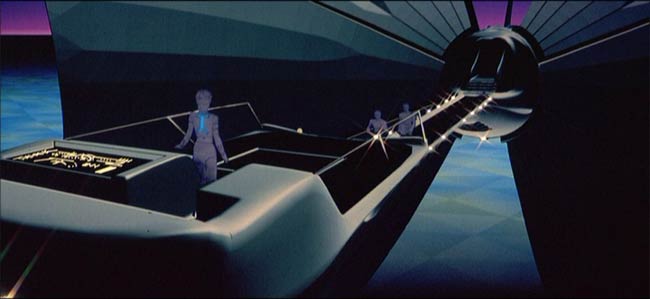
Tron has a rather silly aspect about it in that it continually uses computer terms in non-sensical ways. As steeped in computer-speak as we are today, these stick out like a sore thumb. However, at the time (1982), very few people would have noticed this. The idea was to just get the cyber-atmosphere permeating the movie, which Tron did most effectively. In setting the trend for most most cyberpunk movies that follow, neon colors are “In”, as is the idea of a single dominating color the permeates the movie - in Tron’s case we get mostly blue, along with red representing the bad guys.
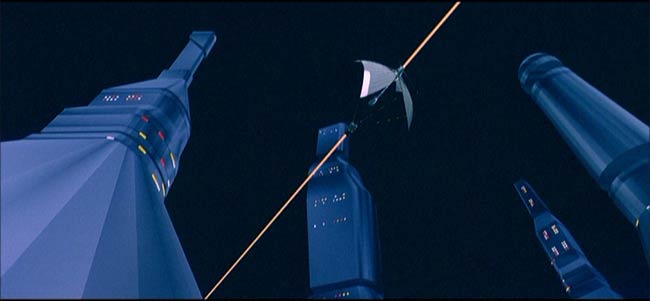
Yes the FX are dated now (God I hope so!). We’re talking about the real early days of computer graphics. Still, some of the shots still hold up well, and overall, the visuals are still very enjoyable. Tron is designed to have a sense of wonder about it - this still works. The car race game in particular is still VERY fun! Another thing that still works is the music accompanyment - Wendy Carlos’s synthesizer-laden soundtrack fits this movie perfectly.
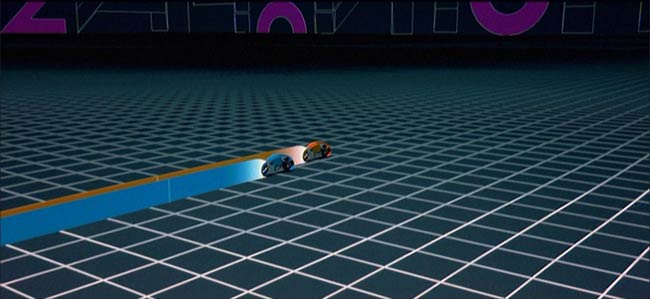
Overview: Jeff Bridges, Babylon Five’s Bruce Boxleitner, and David Warner as the evil bad guy (The exec Ed Dillinger, the game player Sark, and the Voice of the Master Control Program) all provide very fun performances. They are able to make this crazy environment work well enough that it still comes across as a rather cool cyberpunk flick. And truly, if you’re into VR cyberpunk movies, Tron is a MUST SEE - so much so that one point has added to this review score for its historical place in VR films.
~See movies similar to this one~
Tags: cyberpunk movie review Tron
Year: 1987
Directed by: Steve De Jarnatt
Written by: Michael Almereyda, Lloyd Fonvielle
IMDB Reference
Degree of Cyberpunk Visuals: Low
Correlation to Cyberpunk Themes: Low
Key Cast Members:
Glu Glu Lawyer: Laurence Fishburne
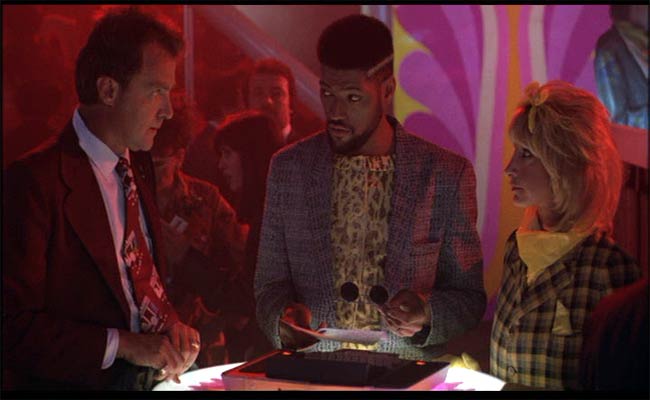
Overview: Cherry 2000 is about a guy named Sam Treadwell (David Andews) who gets too hot and heavy with his perfect android wife while wallowing in soap suds - unfortunately Cherry 2000 doesn’t take to water well and gets fried. After trying his hand at post-modern dating, Sam decides he needs a new body for his Cherry chip - unfortunately the only place they exist now is in a wasteland ruled by thugs. Sam hires Melanie Griffith as his tough-chick guide to navigate through the wasteland to get his new girl.
Truly, the majority of the movie is just not that good. In fact it’s worse than not good, and passes the border to unwatchable. The acting is absolutely horrendous, as are the outfits (intentionally though), as are the set pieces, as is the dialogue, as is the pacing, etc.
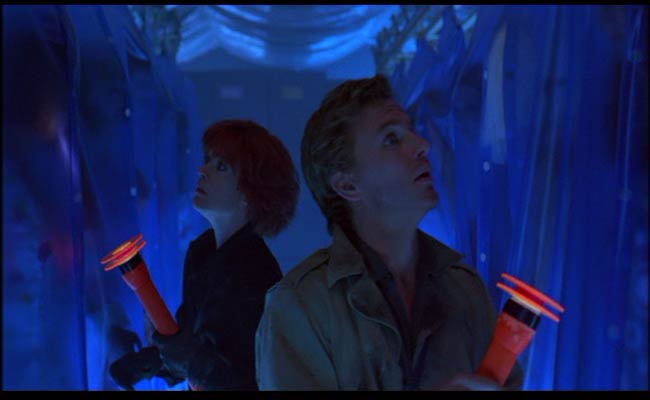
The Bottom Line: If you want to see Melanie Griffith’s worst acting performance, get Cherry 2000. But truly, the reason you might want to get this is, aside from the cool fried cyberchick love scene at the beginning and maybe the “select a love-babe” scene, is for Cherry 2000’s most awesome commentary on dating in the future. Dating in the future requires a lawyer (played wonderfully by Lawrence Fishbourne - the ONLY performance in the movie that shined) and LOTS of negotiations. That scene alone, also thankfully right near the beginning, is almost worth the price of the movie.
~See movies similar to this one~
Tags: cyberpunk movie review
Year: 1988
Directed by: Katsuhiro Ôtomo
Written by: Katsuhiro Ôtomo (comic), Izô Hashimoto
IMDB Reference
Degree of Cyberpunk Visuals: High
Correlation to Cyberpunk Themes: High
Key Cast Members:
Tetsuo Shima: Nozomu Sasaki (voice)
Shôtarô Kaneda: Mitsuo Iwata (voice)
Kei: Mami Koyama (voice)
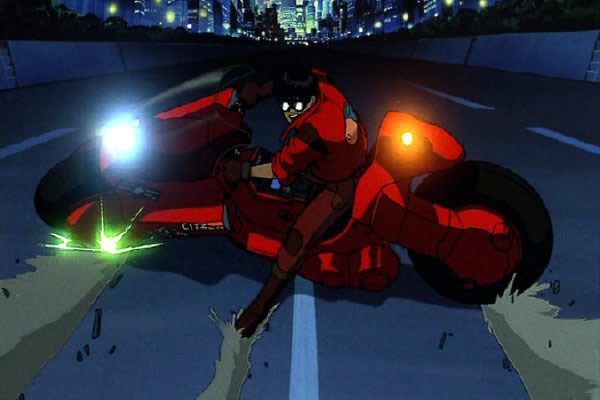
Overview: Many consider Akira to be the start of modern Japanese anime. In comparing Akira with Appleseed (also from 1988), I tend to agree. Appleseed represents high quality earlier anime, whereas Akira is truly something different both in tone and style. Akira definitely strays to the “punk” side of cyberpunk, but has full clashes with the corporate control element and technology run amok.
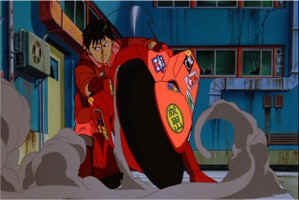 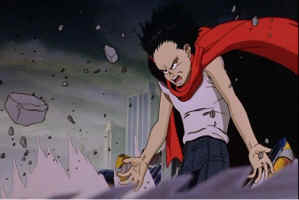
Akira’s story centers around Tetsuo, a member of a biker gang in the year 2019. Along come a group of military scientist types who look to stretch the boundaries of human capability by engaging tetsuo in experiments. Unfortunately for them, the experiments prove far too successful to the point that the develop an all-powerful monster that rages out of control.
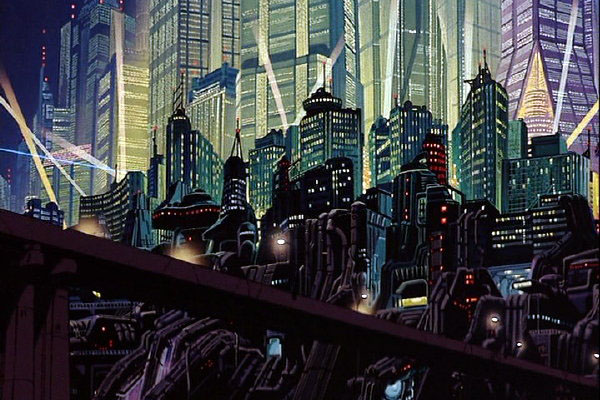
The Bottom Line: Akira has terrific adult visuals and a great sound track. As a personal preference though, I wasn’t as thrilled with the later half of the movie. Some love it, I didn’t nearly as much. There seems to be a debate where people either love this or Ghost in the Shell (guess which one I love?). It almost seemed DragonballZ-like, but again, this is also personal preference. Regardless, Akira is a true giant of anime and should be considered required watching for anyone who wants to learn more about cyberpunk or anime.
~See movies similar to this one~
Tags: cyberpunk movie review anime
Year: 1982
Directed by: Ridley Scott
Written by: Philip K. Dick (Novel), Hampton Fancher & David Peoples
IMDB Reference
Degree of Cyberpunk Visuals: Very High
Correlation to Cyberpunk Themes: Very High
Key Cast Members:
Rick Deckard: Harrison Ford
Roy Batty: Rutger Hauer
Rachael: Sean Young
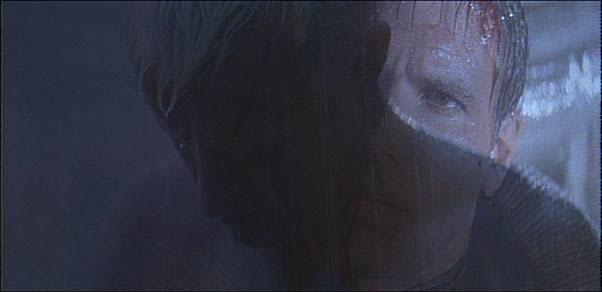
I’ve seen things you people wouldn’t believe. Attack ships on fire off the shoulder of Orion. I watched C-beams glitter in the dark near the Tannhauser gate. All those moments will be lost in time, like tears in rain. Time to die…
Overview: If you read a lot of the reviews from others about movies on this site, you’ll find that over half of them reference Blade Runner in some way, other in the visuals or issues discussed. Along with Gibson’s Neuromancer, Blade Runner did more to establish cyberpunk as a genre. The fact that Blade Runner came two years prior to Neuromancer is rather interesting. Truly, this film set the standard for the near-future film noirs sub-genre we call cyberpunk.
Not too dissimilar to the wrath that greeted Metropolis’ release, Blade Runner was not an instant hit. Instead it grew from being critically panned to a cult classic, to now, where its well on its way to being considered a timeless classic.
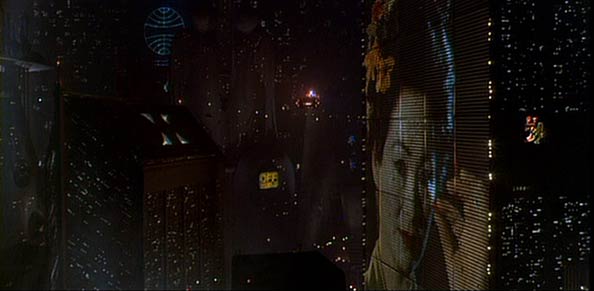
Commerce is our goal here at Tyrell. More human than human is our motto
The Visuals: The visuals in Blade Runner are simply stunning. We see corporate pharaohs ruling a society containing manufactured slaves from their Egyptian style pyramids, while we see rot and decay on the streets below. Noir-style beige and blacks dominate the screen, but are often supplanted by shocking neons. In Blade Runner, we see and Earth in ruin - a place that people are eager to leave. Only the poor and problematic are left on this rain-soaked dystopian planet that has been raped of any semblance of natural existence. The Earth is now almost completely devoid of trees and animals, which are now replaced with artificial ones for the pleasure of mankind.
The Story: Technology and corporate power are clearly the cause for this downfall. Genetic engineering has run rampant, and is combined with advanced organic computing technologies. It is in this world that we find a cast of flawed characters. Nobody is pure, nobody pristine. They are all a product of the environment they live in.
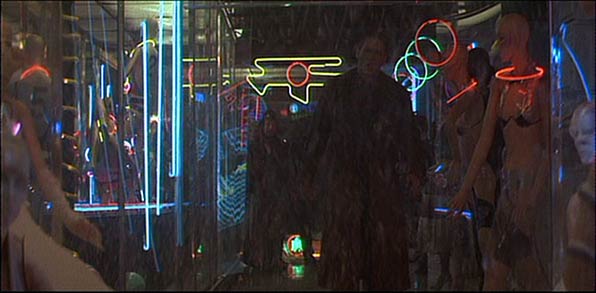
Replicants are like any other machine - they’re either a benefit or a hazard. If they’re a benefit, it’s not my problem.
To augment humanity’s needs and desires, replicants, or genetically engineered humans imbued with artificial intelligence have been developed. They serve many important roles including protection, pleasure slaves, and hard labor for the most dangerous environments. While replicants start out as rather straightforward and useful machines, over time, they start to develop awareness - their own personality, and eventually, free will and a desire for self-preservation. Because they are defined as property, Replicants are given a 4-year lifespan, which is enforced upon inception, and is irreversible.
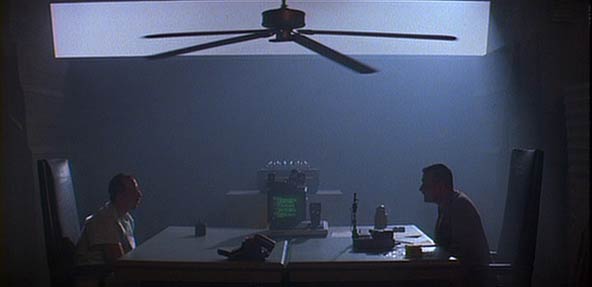
My mother? Let me tell you about my mother!
It is in this world that we encounter Deckard (Harrison Ford), a Blade Runner. Blade Runners are cops who hunt down Replicants. At the beginning of the movie, we find that Deckard has supposedly retired from the business.I say supposedly here, because if he is a replicant, then really, he has been imbued with false memories as well, and in fact has never been a blade runner prior to this. Really, he is just filling in as a laborer fulfilling another job that is too dangerous for humans.
Deckard is brought back in to "retire" 4 runaway "skin jobs" (replicants) who have murdered humans off-world and have escaped to Earth. Apparently, they seem to be interested in coming back to their creators - the Tyrell corporation. The story expands from there, and truly touches on some wonderful questions concerning ethical dilemmas that most certainly will arise in the future.
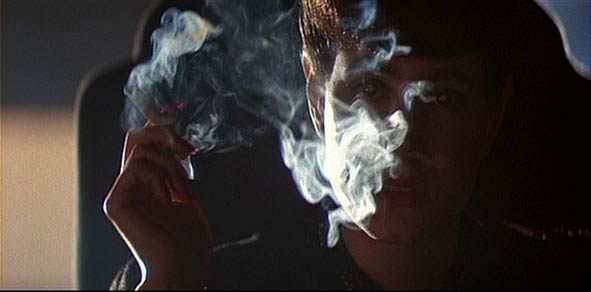
Are these questions testing whether I’m a replicant or a lesbian, Mr. Deckard?
I’m not in the business. I AM the business… Deckard encounters Rachael (played wonderfully by Sean Young), a replicant who during the movie discovers her true nature. Blade Runner does a masterful job of exploring the questions and emotions surrounding this. We see Rachael’s theme echoed in Natural City, Armitage, Thirteenth Floor, Ghost in the Shell, Serial Experiments Lain, Malice@Doll, the Animatrix, I, Robot, and others. This question about what degree artificial life forms are human is a central theme of the cyberpunk genre.
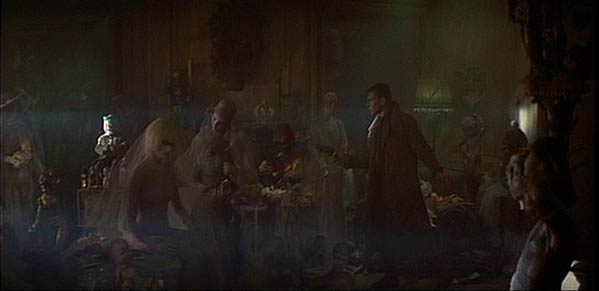
What is Human? While other movies have been terrific in exploring this, Blade Runner still sits at the top of the list, both for Racheal, and for Roy Batty, the leader of the renegade replicants. Roy’s monologue near the end (see the quote at the top), which was supposedly adlibbed by Rutger Hauer, captures in a single moment the ethical dilemma with creating sentient life. If they have freewill, can they really be considered property? And if they aren’t property, what are they, exactly?
Blade Runner uses mannequins and toys as its set piece for representing this dilemma. In Blade Runner, corporations create these glorified toys - moving mannequins if you will, to meet the needs of society, yet while the toys themselves are clearly a product of the society just like all the other noir characters, are they truly nothing more? And if we do consider them to be on par with humans, what obligations do they have to their creators, who invested time and money in their creation?
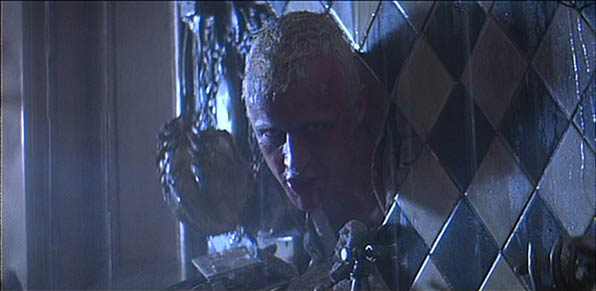
The light that burns twice as bright burns half as long - and you have burned so very, very brightly, Roy.
The Bottom Line: On top of all this philosophical questioning, we get some great noir-detective-like action and suspense. Roy Batty is truly a badass. Deckard’s pursuit of him is a very fun engagement, as is the climax. Its flat out terrific. The pacing is wonderful, the visuals are astounding, and the story is enthralling. By now I’m guessing most have seen this cinematic masterpiece, but if not, you are truly in for feast!
Page 2 - More Screen Captures–>>
~See movies similar to this one~
Tags: cyberpunk movie review
Year: 1988
Directed by: Shinya Tsukamoto
Written by: Shinya Tsukamoto
IMDB Reference
Degree of Cyberpunk Visuals: Very High
Correlation to Cyberpunk Themes: Very High
Rating: 10 out of 10
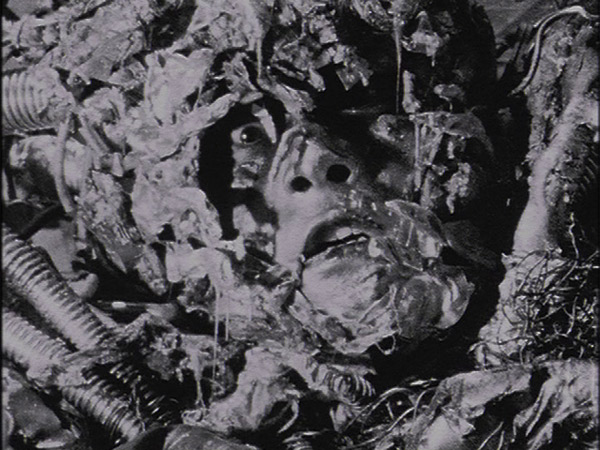
Overview: For another movie that taps out the weird shitometer scale, and the pinnacle of Japanese cyberpunk flicks, Tetsuo is simply terrific! I must warn you that this movie is NOT for everyone. We get a bevy of disturbing images, including extreme body manipulation, anal rape of a guy by a mechanically "enhanced" female, rape in the reverse by a man with a literal "power tool," and truly the most bizarre set of images one can imagine. But in all this, there are some truly interesting messages that emerge. Unlike other Japanese Cyberpunk films such as Rubber’s Lover, which is more of a one track film (extreme situations to prompt greater than human abilities), Testsuo provides a wonderful commentary on the direction of mankind.
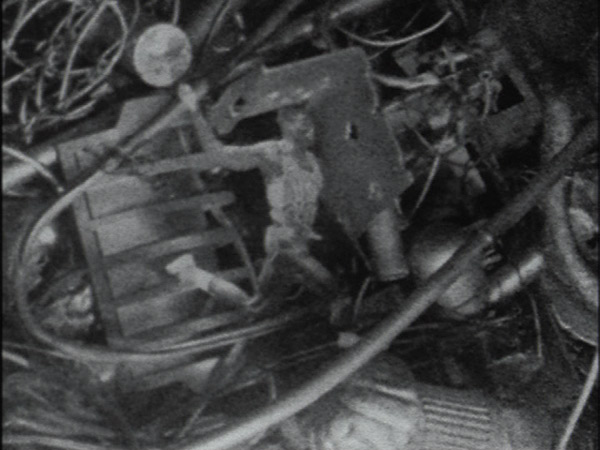
This is one of the best opening symbols for any movie I can remember. It sums up Tsukamoto’s message perfectly!
Tetsuo’s Message: While Tetsuo is a really bizarre, low budget, surrealist underground Japanese cyberpunk movie, it has a number of interesting themes running through it. On a societal level, Tetsuo explores how man’s technological dash to the future has resulted in an acute fear of technology, and that its ever encroaching progress is destroying our humanity. This is symbolically represented by a runner surrounded by scrap metal, and then later, a man in running gear who’s slowly being taken over by machinery when competing with another machine man.
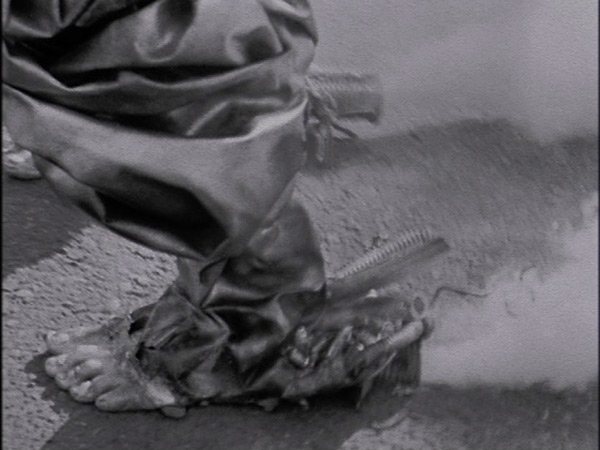
The clear message at the end is that by constantly competing with one another in our strive for perfection in an orderly society, we are destroying humanity at its core. Technology is our tool of choice for this destructive competition. The shot of the augmented foot above really captures this well, as does the race scene below.
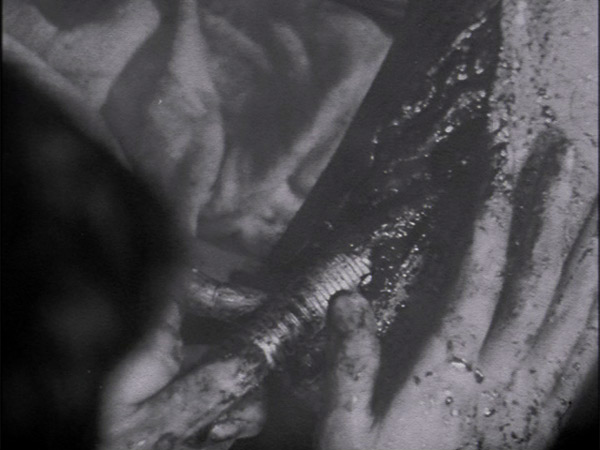
I can’t convey how truly disgusting this scene comes across
On a personal level, Tetsuo explores how guilt and repression can turn people into virtual "monsters." In this, we see an instance where an accidental car crash makes someone completely lose all sense of humanity and boundaries. This seems to fit with Asian cultures in that they are usually very reserved, but when they "cross" that line, the level of anger and craziness almost doesn’t have a limiter.
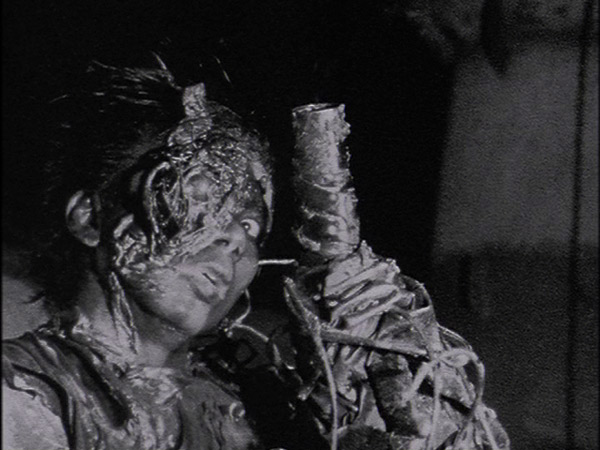
In combining this with the societal thought, Tetsuo posits that we are using technology as a crutch to cover up our own frailties, but that in doing so, we only serve to subvert our humanity. When this subversion is released, it becomes a perversion of immense proportions. In this sense, Tetsuo truly stretches the cyberpunk notion of "no boundaries" to its fullest.
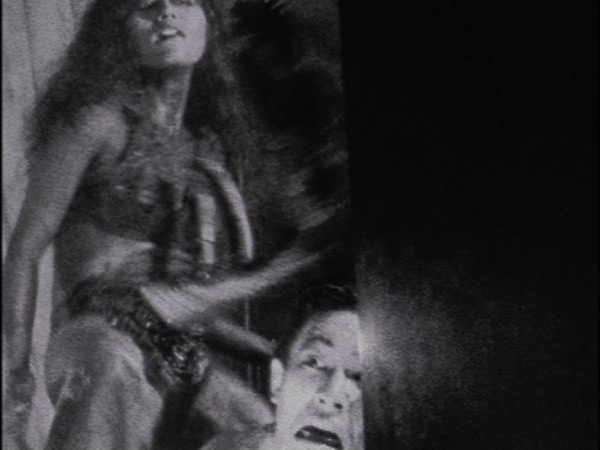
Yes, she’s about to do what you "think" she’s planning to do with that thing!"
The Bottom Line: Tetsuo is a great example of what a low-budget scifi film can accomplish. I thought the cinematography is absolutely brilliant. We get cool stop-motion animation, incredibly interesting shadows and film angles, and wonderful use of different shot textures. The industrial sound track furthers the truly bizarre mood. Truly, I can’t say enough of how impressed I am by this film. Again, Tetsuo is DEFINITELY not for everyone, but it certainly belongs in the top 10 best cyberpunk films ever made!
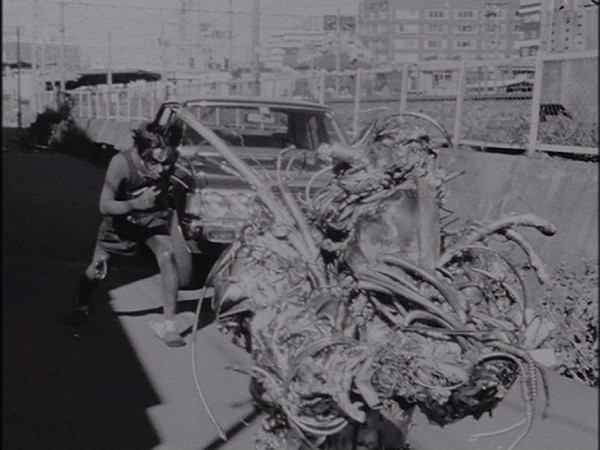
Screen Captures - ADULTS ONLY: I do have a second page of screen captures, but I MUST warn you - these are VERY graphic. They show one of the most intense sex and violence scenes every put on film. If you want to get a sense of he the extent that Japanese cyberpunk fullfills its “no boundaries” approach, take a look. But this page is intended for adults - and truly, only a few select few of those. Don’t look if you’re not comfortable with watching these things.
Tetsuo Page 2: Screen Caps - ADULTS ONLY–>>
|



























